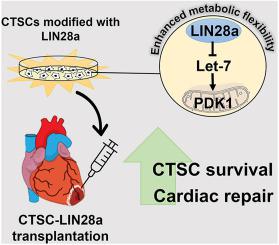Redox Biology ( IF 11.4 ) Pub Date : 2021-10-08 , DOI: 10.1016/j.redox.2021.102162 Antonia Elizabeth Yuko 1 , Vagner Oliveira Carvalho Rigaud 1 , Justin Kurian 1 , Ji H Lee 1 , Nicole Kasatkin 1 , Michael Behanan 1 , Tao Wang 2 , Anna Maria Luchesse 3 , Sadia Mohsin 4 , Walter J Koch 3 , Hong Wang 1 , Mohsin Khan 5

|
Rationale
Cell-based therapeutics have been extensively used for cardiac repair yet underperform due to inability of the donated cells to survive in near anoxia after cardiac injury. Cellular metabolism is linked to maintenance of cardiac stem cell (CSC) renewal, proliferation and survival. Ex vivo expansion alters (CSC) metabolism increasing reliance on oxygen dependent respiration. Whether promoting ‘metabolic flexibility’ in CSCs augments their ability to survive in near anoxia and repair the heart after injury remains untested.
Objective
Determine the effect of LIN28a induced metabolic flexibility on cardiac tissue derived stem like cell (CTSC) survival and repair after cardiac injury.
Methods and results
LIN28a expression coincides during heart development but is lost in adult CTSCs. Reintroduction of LIN28a in adult CTSC (CTSC-LIN) increased proliferation, survival, expression of pluripotency genes and reduced senescence compared to control (CTSC-GFP). Metabolomic analysis show glycolytic intermediates upregulated in CTSC-LIN together with increased lactate production, pyruvate kinase activity, glucose uptake, ECAR and expression of glycolytic enzymes compared to CTSC-GFP. Additionally, CTSC-LIN showed significantly reduced ROS generation and increase antioxidant markers. In response to H2O2 induced oxidative stress, CTSC-LIN showed increased survival and expression of glycolytic genes. LIN28a salutary effects on CTSCs were linked to PDK1/let-7 signaling pathway with loss of PDK1 or alteration of let-7 abrogating LIN28a effects. Following transplantation in the heart after myocardial infarction (MI), CTSC-LIN showed 6% survival rate at day 7 after injection compared to control cells together with increased proliferation and significant increase in cardiac structure and function 8 weeks after MI. Finally, CSTC-LIN showed enhanced ability to secrete paracrine factors under hypoxic conditions and ability to promote cardiomyocyte proliferation following ischemic cardiac injury.
Conclusions
LIN28a modification promotes metabolic flexibility in CTSCs enhancing proliferation and survival post transplantation including ability to repair the heart after myocardial injury.
中文翻译:

LIN28a诱导的代谢和氧化还原调节促进缺血性损伤后心脏细胞存活
基本原理
基于细胞的疗法已广泛用于心脏修复,但由于捐赠的细胞在心脏损伤后无法在接近缺氧的情况下存活,因此表现不佳。细胞代谢与维持心脏干细胞 (CSC) 更新、增殖和存活有关。离体扩张改变(CSC)代谢增加对氧依赖呼吸的依赖。促进 CSC 的“代谢灵活性”是否会增强其在缺氧附近生存和受伤后修复心脏的能力仍有待检验。
客观的
确定 LIN28a 诱导的代谢灵活性对心脏组织衍生干细胞 (CTSC) 存活和心脏损伤后修复的影响。
方法和结果
LIN28a 表达在心脏发育期间一致,但在成人 CTSC 中丢失。与对照 (CTSC- GFP ) 相比,在成人 CTSC (CTSC- LIN )中重新引入 LIN28a增加了增殖、存活、多能性基因的表达并减少了衰老。代谢组学分析显示,与 CTSC- GFP相比,CTSC- LIN中的糖酵解中间体上调,同时增加了乳酸产生、丙酮酸激酶活性、葡萄糖摄取、ECAR 和糖酵解酶的表达。此外,CTSC- LIN显示出显着减少的 ROS 生成和增加抗氧化标志物。为了应对 H2O2 诱导的氧化应激,CTSC- LIN显示糖酵解基因的存活和表达增加。LIN28a 对 CTSCs 的有益作用与 PDK1/let-7 信号通路相关,PDK1 缺失或 let-7 改变消除了 LIN28a 作用。在心肌梗死 (MI) 后移植到心脏后,CTSC- LIN在注射后第 7 天与对照细胞相比显示 6% 的存活率,同时在 MI 后 8 周增殖增加和心脏结构和功能显着增加。最后,CSTC-LIN 显示出在缺氧条件下分泌旁分泌因子的能力增强,以及在缺血性心脏损伤后促进心肌细胞增殖的能力。
结论
LIN28a 修饰促进 CTSC 的代谢灵活性,增强移植后的增殖和存活,包括心肌损伤后修复心脏的能力。



























 京公网安备 11010802027423号
京公网安备 11010802027423号